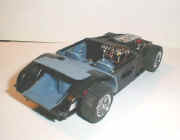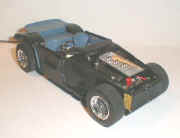 |
|||||||||||
|
Cars |
|||||||||||
|
Ferrari 250 SWB Italeri 1/24 scale |
|||||||||||
|
by Martin Swire |
|||||||||||
|
Legal Notice No material from Modeler Site any Web site owned, operated, licensed, or controlled by Mario Covalski & Associated may be copied, reproduced, republished, uploaded, posted, transmitted, or distributed in any way, except that you may download one copy of the materials on any single computer for your personal, non-commercial home use only, provided you keep intact all copyright and other proprietary notices. Modification of the materials or use of the materials for any other purpose is a violation of Mario Covalski & Associated's copyright and other proprietary rights. Read More here > Legal notice The 250 SWB was one of Ferrari's most successful models. Produced from 1959 to 1962 it was based on the 250 GT Tour de France. The 2953cc V12 (type 128) engine of the Tour de France was developed into the type 168 for the SWB and produced 240 bhp in road guise or 280 bhp for the 'Comp 1' engine.
The secret of its success was in its handling which made it eminently suitable for road racing; with a top speed in excess of 150mph it was not slow in a straight line either. The GT chassis was shortened by only 200mm, but it was this small modification that transformed the car from very good to exceptional, and gave it the name SWB, or 'Short Wheelbase Berlinetta'. (250, as with all Ferrari's of the time, is the figure arrived at by dividing the approximate cubic capacity by the number of cylinders, in this case 3000 divided by 12). When I got this kit I was tired of painting red Ferrari's and decided that I needed something different. I decided to build one of the Rob Walker cars that Stirling Moss had driven to victory in both the 1960 and 1961 TT races at Goodwood. Moss drove the 1961 car again at the Goodwood Revival meeting on his 70th birthday in 1999. The most obvious thing about the car is the striking Rob Walker team colours with the white band running across the nose. Less obvious, at first sight, is that it is Right Hand Drive. You've guessed it - the car in the kit was a left hooker! One of the things that identifies early and late SWB's is that the side direction indicator lights are round on the early cars and peardrop shaped on the later ones. This kit depicted one the later models and so I decided to have a go at replicating the 1961 winner. The Kit and Build Converting the model to right hand drive involves changing over the footwells, adapting the inner wings to fit the bulkhead, and of course altering the dashboard and moving the steering wheel and handbrake across. I did not want to loose any of the detail in the facia panel and so I took the measurements and made a scale drawing of the panel and top rail before cutting the facia from it. A new top rail was then made and the facia cut into three pieces. The two outer pieces could then be changed over so that the steering was on the right. A notch had to be cut in the new top rail to take the drivers instrument cluster and the 'hump' in front of it made out of epoxy putty. Instrument bezels were detailed with Bare Metal Foil and 'set' with Johnson's Klear, decals applied and the glass simulated with Humbrol Clearfix.
The body of the model is in four pieces - main shell, front and rear valances and the bonnet (or hood, if you prefer). A small amount of work has to be done to blend the main pieces into one, and the remainder of the body needs work to smooth out various mould lines etc. For the Rob Walker car the rear hazard lights and the fitting points for the front and rear bumpers have to be removed together with the mountings for the Pininfarina logos on each side under the air intake louvres. The original flush fitting petrol cap also has to be replaced with a chrome quick release type. This was easily made from Milliput putty and covered with Bare Metal Foil
I had used a white primer for the body but I found that the dark blue finish would not cover the white around the raised detail areas on the air intakes. In trying to correct this I applied too much paint and tried to stop it running by applying heat with the hairdryer. All looked OK at first and I was quite pleased with the result and it wasn't until I returned to the model later that I saw that the whole of the front bodywork had sagged! There was no way of retrieving this situation and so, furious with myself, the body was consigned to the bin and the chassis returned to its box.
Over the next few weeks I kept a check on ebay and searched the net for another kit. I had imported the original from Germany and didn't realise then just how difficult they were to source. Help arrived in the form of two great guys in the States. Stu Benford in Ohio thought he knew where to find another kit and made a special trip to try and acquire it - unfortunately it had been sold. It was thanks to Earl Petrikin in Florida that my project finally got going again when he very generously split up one of his own kits and sent me the body parts that I needed! For this selfless act I will be eternally grateful - thanks Earl. And thanks to Stu as well, for trying so hard.
It's one thing to mess up your own kit and quite another to do it with someone elses, especially when you now know you are now dealing with a rarity, and so it was with a certain amount of nervousness that I set about the 'new' body.
For the second body I used a dark grey primer before the Midnight Blue paint. When this was polished the band and roundels were applied. The main problem was in the band which I had thought was a straight white stripe.
Bare Metal Foil was used for the window chrome and the Moss lucky '7' cut from black Solartrim. This a very thin self adhesive sheet material used by the Aero Modelling fraternity and available in a variety of colours. I used a graphics program to make the number and then stuck this to the back of the Solartrim sheet and cut the numbers out with a sharp knife. The number was then gently sanded to take off the shine. Thanks to Stu Benford and Earl Petrikin, without whom the chassis would still be in the box, for their encouragement, advice and practical help and of course Roberto at ICARO. Paint
|
|||||||||||








